Cambodia’s vibrant capital city, Phnom Penh, sits at the confluence of the Mekong and Tonle Sap rivers, where ancient Khmer heritage meets modern Southeast Asian energy. This bustling metropolis of nearly 2 million people serves as the political, economic, and cultural heart of Cambodia, offering visitors an authentic glimpse into both the country’s tragic past and its hopeful future.
Founded in 1434, Phnom Penh has survived centuries of change, from its golden age as a royal capital to the devastation of the Khmer Rouge era and its remarkable recovery in recent decades. Today, the city pulses with life as tuk-tuks weave through traffic-filled streets, street vendors serve steaming bowls of noodle soup, and ancient temples stand proudly alongside modern shopping centers.
What makes Phnom Penh truly compelling is its ability to tell Cambodia’s complete story. The city doesn’t shy away from its dark chapters – the Tuol Sleng Genocide Museum and Choeung Ek Killing Fields serve as powerful reminders of the country’s struggle. Yet it also celebrates its resilience through magnificent palaces, bustling markets, and a thriving arts scene that showcases Cambodia’s enduring spirit.
The city’s location at the meeting point of three rivers has shaped its character throughout history. French colonial architecture lines tree-shaded boulevards, while traditional Khmer temples anchor neighborhoods filled with friendly locals eager to share their stories. Modern cafes and restaurants serve both traditional Khmer cuisine and international dishes, reflecting the city’s growing cosmopolitan character.
Visitors to Phnom Penh will find a city that challenges and rewards in equal measure. The heat and humidity can be intense, the traffic chaotic, and some historical sites emotionally difficult. But the warmth of the Cambodian people, the richness of the culture, and the incredible value for money make it an essential destination for anyone seeking to understand Southeast Asia’s complex history and bright future.
Let’s explore the ten most significant and captivating places that showcase why Phnom Penh deserves a prominent place on every Southeast Asian itinerary.
1. Royal Palace and Silver Pagoda – Khmer Architectural Grandeur
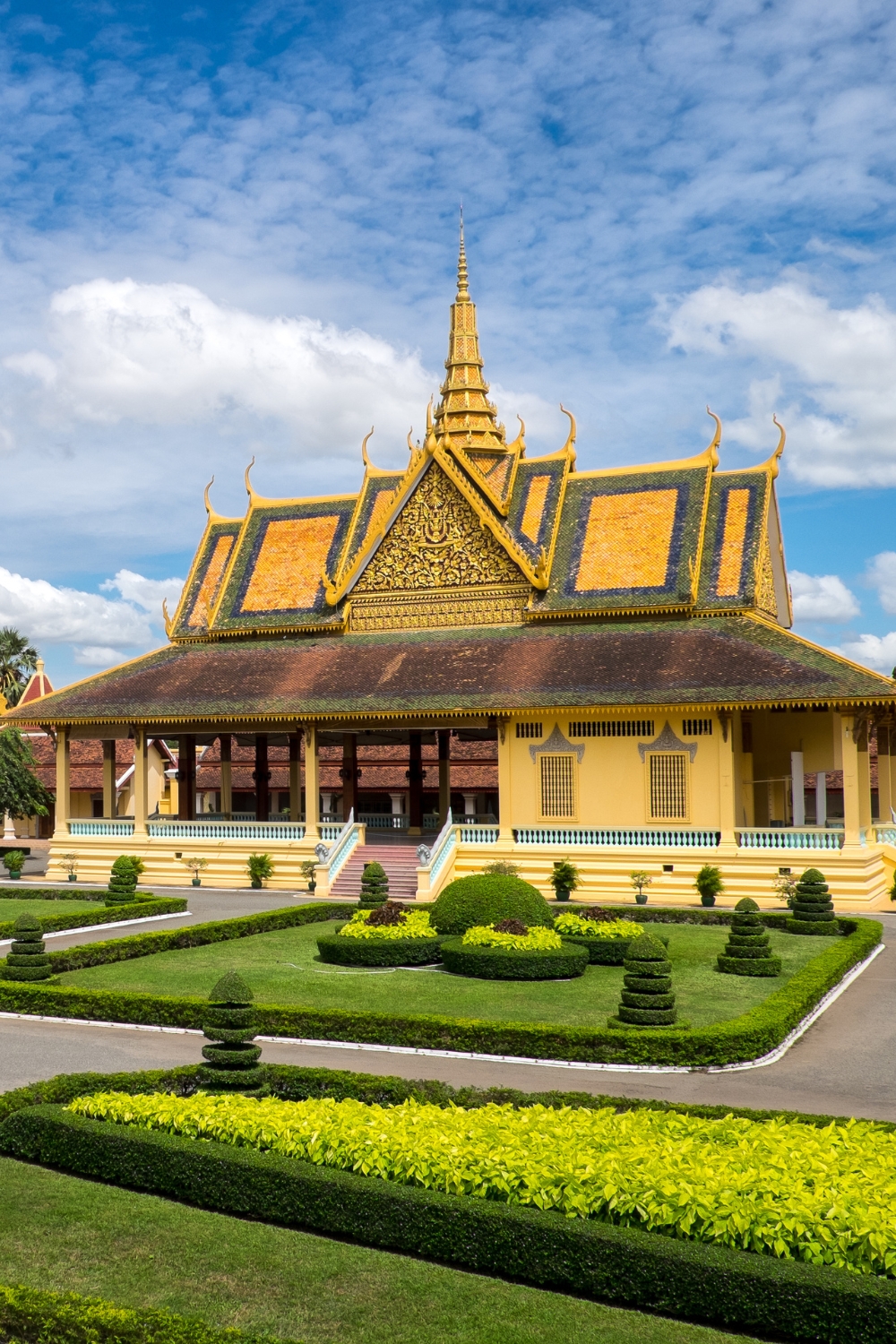
The Royal Palace complex stands as Phnom Penh’s most magnificent architectural achievement and serves as the official residence of Cambodia’s king. Built in 1866 during the reign of King Norodom, this sprawling complex showcases traditional Khmer architecture at its finest, with golden spires, intricate carvings, and buildings that seem to float above manicured gardens.
Palace Architecture and Royal Heritage
The palace complex consists of multiple buildings, each serving different ceremonial and residential functions. The Throne Hall, with its distinctive tiered roof and golden spires, hosts royal ceremonies and state functions. The architecture follows traditional Khmer design principles, with buildings elevated on platforms and roofs that sweep upward in graceful curves.
Visitors can explore the public areas of the palace, including ceremonial halls, reception rooms, and gardens that demonstrate the refinement of Cambodian royal culture. The buildings showcase traditional building techniques using local materials, combined with decorative elements that reflect both Khmer and French colonial influences.
The Silver Pagoda’s Sacred Treasures
Within the palace complex, the Silver Pagoda (Wat Preah Keo) houses Cambodia’s most sacred Buddhist artifacts. The pagoda gets its name from the 5,000 silver tiles that cover its floor, each weighing over a kilogram. The building serves as a temple and museum, containing priceless Buddha statues, royal regalia, and religious artifacts.
The pagoda’s most famous treasure is the Emerald Buddha, carved from a single piece of crystal and adorned with gold and diamonds. Other notable artifacts include a life-sized golden Buddha decorated with precious stones and ancient palm leaf manuscripts that preserve Buddhist teachings.
Opening hours: Daily 8:00 AM – 5:00 PM
Entry fee: $10 USD
Dress code: Covered shoulders and knees required
Best time: Early morning for cooler temperatures
2. Tuol Sleng Genocide Museum (S-21) – Historical Testimony
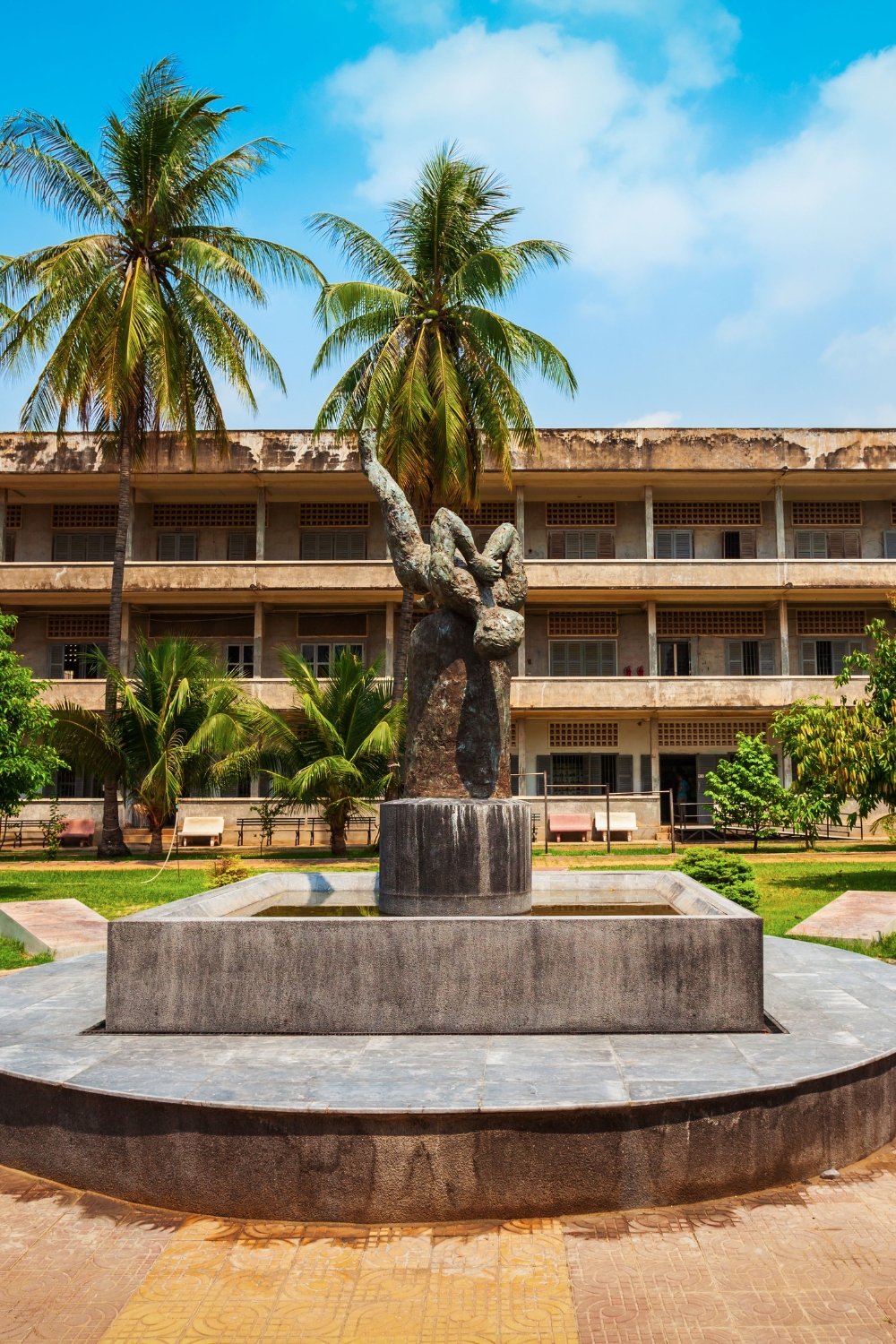
The Tuol Sleng Genocide Museum, housed in the former S-21 prison, provides essential historical context for understanding Cambodia’s recent past. This former high school was converted into a detention and torture center during the Khmer Rouge regime (1975-1979), and today serves as a museum documenting one of the 20th century’s most tragic genocides.
Preserved Evidence and Historical Documentation
The museum maintains the prison exactly as it was found when Vietnamese forces liberated Phnom Penh in 1979. Visitors can walk through the former classrooms that were converted into tiny prison cells, torture chambers, and interrogation rooms. The preserved buildings serve as powerful evidence of the systematic brutality of the Khmer Rouge regime.
Photographs of thousands of prisoners cover the walls, creating a haunting memorial to the estimated 14,000 people who were detained here. Only seven prisoners survived S-21, and their testimonies help visitors understand the human cost of political extremism and the importance of protecting human rights.
Educational Impact and Reflection
The museum serves not only as a memorial but as an educational center that helps visitors understand how societies can descend into violence and the importance of preventing genocide. Audio guides provide detailed explanations of the historical context, the prison’s operation, and survivor testimonies.
The experience is emotionally challenging but historically essential. Many visitors find that understanding this dark chapter helps them better appreciate Cambodia’s remarkable recovery and the resilience of its people. The museum emphasizes education and prevention rather than simply documenting past atrocities.
Opening hours: Daily 8:00 AM – 5:00 PM
Entry fee: $5 USD (audio guide $3 USD additional)
Duration: 2-3 hours recommended
Emotional preparation: Historically significant but emotionally challenging
3. Central Market (Psar Thmei) – Art Deco Commerce
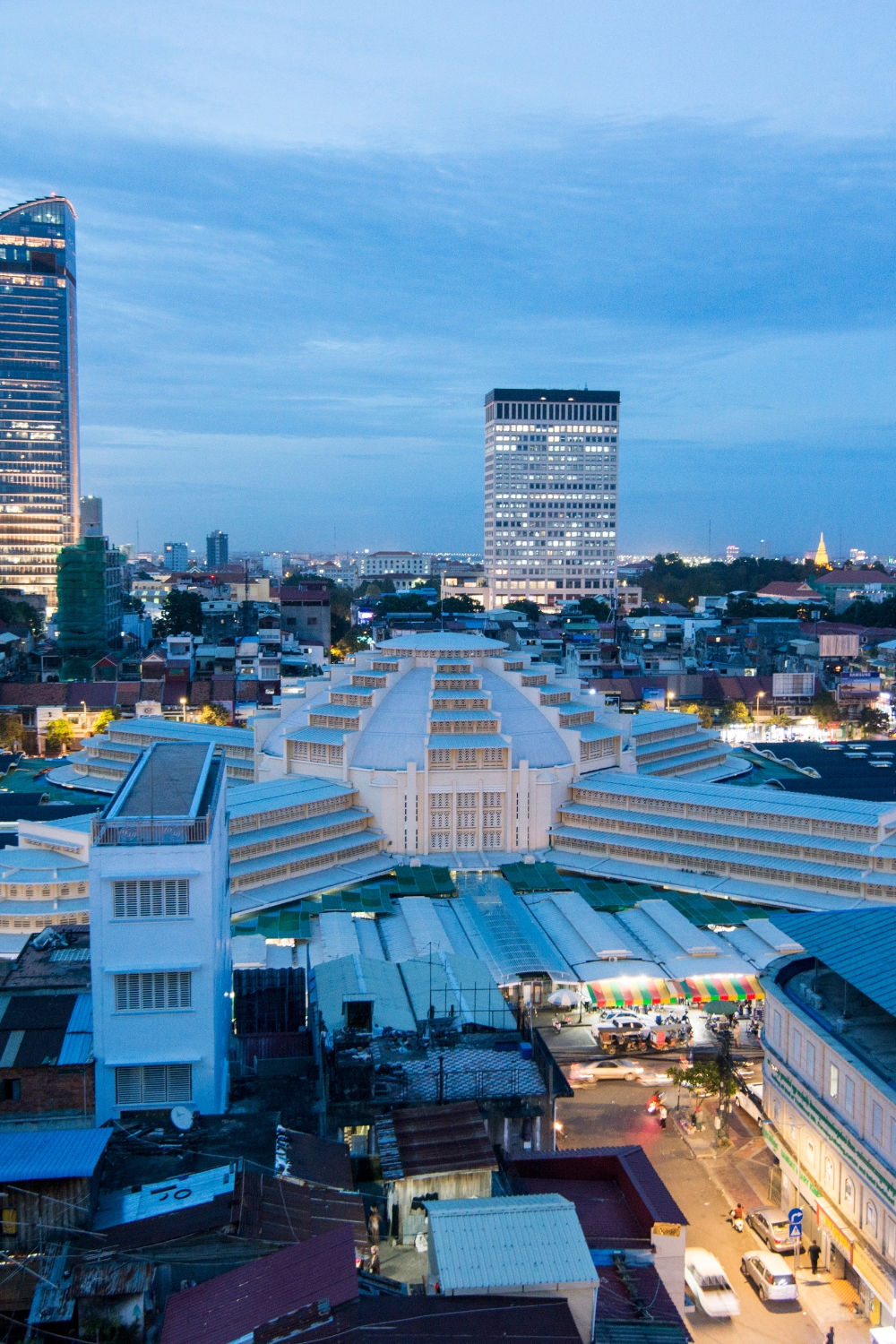
Central Market, known locally as Psar Thmei (New Market), represents one of Southeast Asia’s most architecturally distinctive markets. Built in 1937 during the French colonial period, this Art Deco masterpiece features a central dome surrounded by four wings that create one of the region’s most organized and visually striking shopping experiences.
Architectural Marvel and Design
The market’s distinctive yellow dome rises 26 meters above the shopping floor, creating a natural ventilation system that keeps the interior surprisingly cool despite Phnom Penh’s tropical heat. The Art Deco design incorporates both European architectural principles and adaptations for the local climate, resulting in a building that’s both beautiful and functional.
The four wings extend from the central dome like arms of a cross, each specializing in different types of goods. This organization makes navigation easier than in most Southeast Asian markets, while the high ceilings and open design create a more comfortable shopping environment.
Shopping and Local Products
The market offers an incredible variety of goods, from traditional Cambodian silk and handicrafts to modern electronics and clothing. The central dome area specializes in jewelry, gemstones, and precious metals, while the surrounding wings offer everything from fresh produce to souvenirs.
Bargaining is expected and part of the cultural experience, but prices are generally reasonable even before negotiation. The market provides excellent opportunities to purchase authentic Cambodian products, including traditional textiles, silver jewelry, and local handicrafts that support traditional artisan communities.
Opening hours: Daily 7:00 AM – 6:00 PM
Best for: Souvenirs, textiles, jewelry, local products
Atmosphere: Organized, architectural interest, moderate crowds
Bargaining: Expected and culturally appropriate
4. Wat Phnom – Legendary Temple Hill
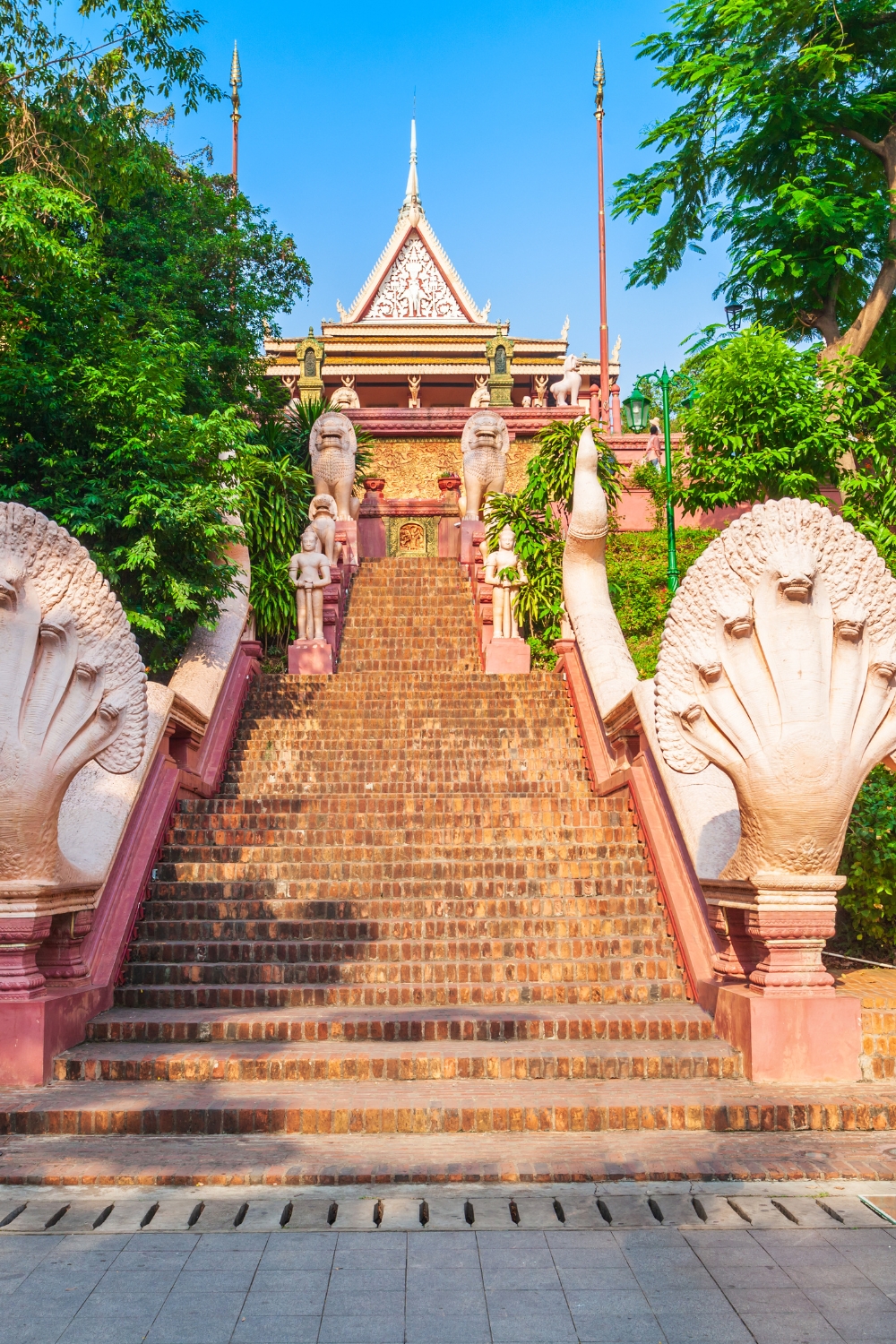
Wat Phnom, the temple that gave Phnom Penh its name, sits atop the city’s only hill and serves as both a religious site and the legendary birthplace of Cambodia’s capital. According to local legend, a wealthy widow named Penh found four Buddha statues in a tree floating down the Mekong River and built a temple on an artificial hill to house them, creating “Phnom Penh” (Hill of Penh).
Historical Significance and Religious Practice
The current temple structure dates to 1926, built to replace earlier versions destroyed by time and conflict. The temple remains an active place of worship where local Cambodians come to pray, make offerings, and seek blessings for important life events. The constant flow of worshippers creates an authentic spiritual atmosphere that contrasts with more touristy temple sites.
The temple complex includes the main prayer hall, several smaller shrines, and gardens that provide peaceful spaces for meditation and reflection. Traditional Khmer architecture elements include intricate wood carvings, colorful murals depicting Buddhist stories, and ceremonial objects that demonstrate the continuing importance of Buddhism in Cambodian life.
City Views and Cultural Observation
While not dramatically elevated, Wat Phnom’s hilltop location provides some of the best views available in this relatively flat city. The temple grounds offer perspectives over the surrounding neighborhoods, the Mekong River, and the city’s mix of traditional and modern architecture.
The temple area attracts not only religious pilgrims but also families enjoying the gardens, students studying in quiet corners, and elderly people meeting friends. This mix of activities creates excellent opportunities for cultural observation and understanding daily life in contemporary Cambodia.
Opening hours: Daily 6:00 AM – 6:00 PM
Entry fee: $1 USD
Activities: Temple visits, city views, cultural observation
Best time: Early morning or late afternoon for cooler temperatures
5. Russian Market (Psar Tuol Tom Pong) – Authentic Local Experience
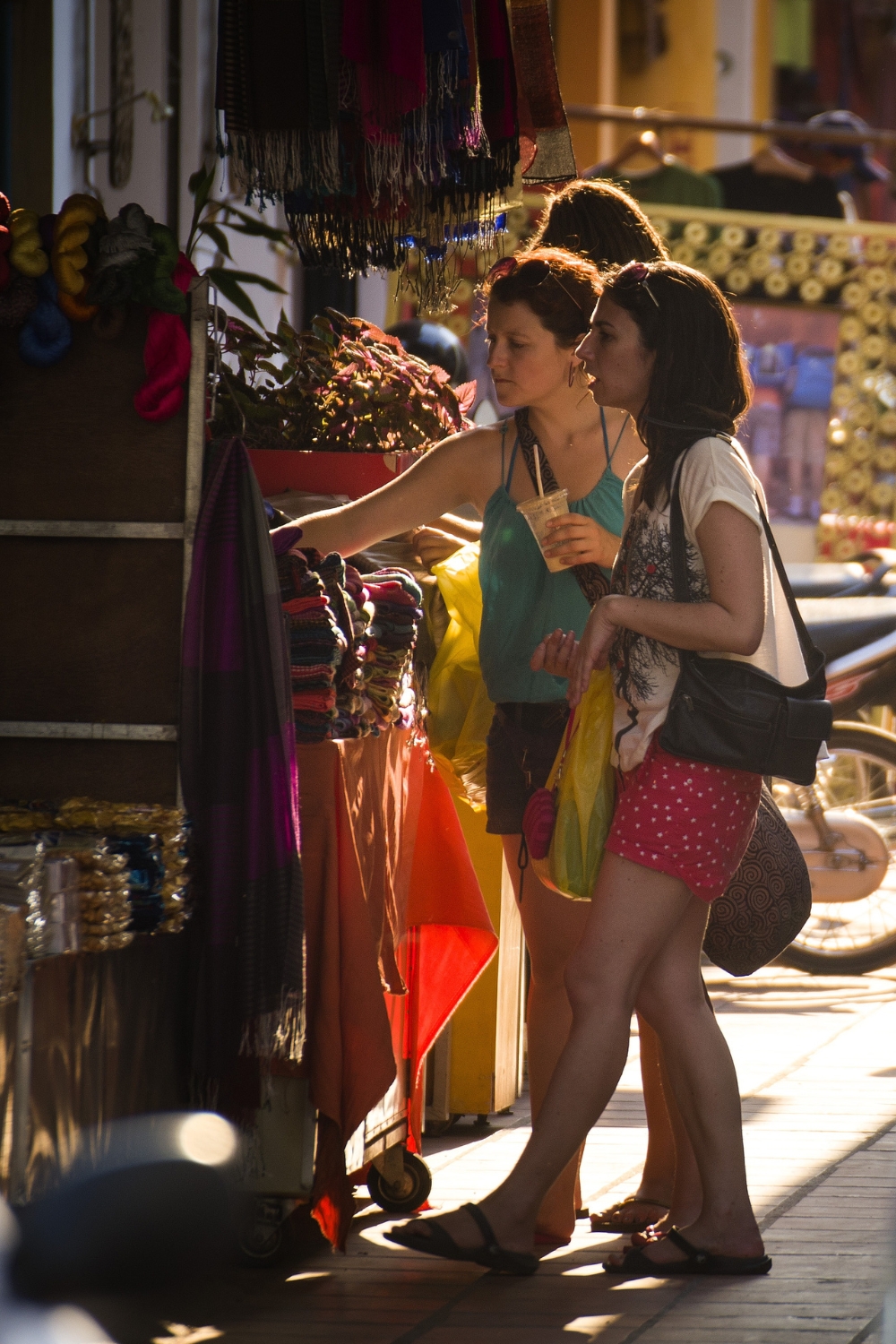
The Russian Market, officially known as Psar Tuol Tom Pong, earned its nickname during the 1980s when Russian expatriates frequently shopped here. Today, it represents one of Phnom Penh’s most authentic market experiences, offering everything from antiques and handicrafts to street food and daily necessities in a bustling, distinctly local atmosphere.
Antiques and Unique Finds
The Russian Market has developed a reputation as the best place in Phnom Penh to find authentic antiques, vintage items, and unique handicrafts. Vendors offer everything from ancient Khmer artifacts (though be cautious about authenticity and export restrictions) to French colonial-era collectibles and traditional textiles.
Unlike more tourist-oriented markets, the Russian Market caters primarily to locals, which means prices are more reasonable and the selection more diverse. Serious collectors and bargain hunters can spend hours exploring the maze of stalls, discovering everything from vintage jewelry to traditional musical instruments.
Street Food and Local Cuisine
The market’s food section provides some of Phnom Penh’s most authentic and affordable dining experiences. Local vendors serve traditional Cambodian dishes like fish amok (steamed fish curry), nom banh chok (Khmer noodles), and various grilled meats and vegetables at prices that attract local workers and families.
The food court atmosphere allows visitors to observe local dining customs and try dishes that might not be available in restaurants catering to tourists. The communal eating areas provide opportunities for cultural exchange and conversation with local diners.
Opening hours: Daily 6:00 AM – 6:00 PM
Best for: Antiques, handicrafts, street food, local culture
Atmosphere: Authentic, bustling, local-focused
Navigation: Can be confusing – allow extra time for exploration
6. Choeung Ek Killing Fields – Memorial and Education
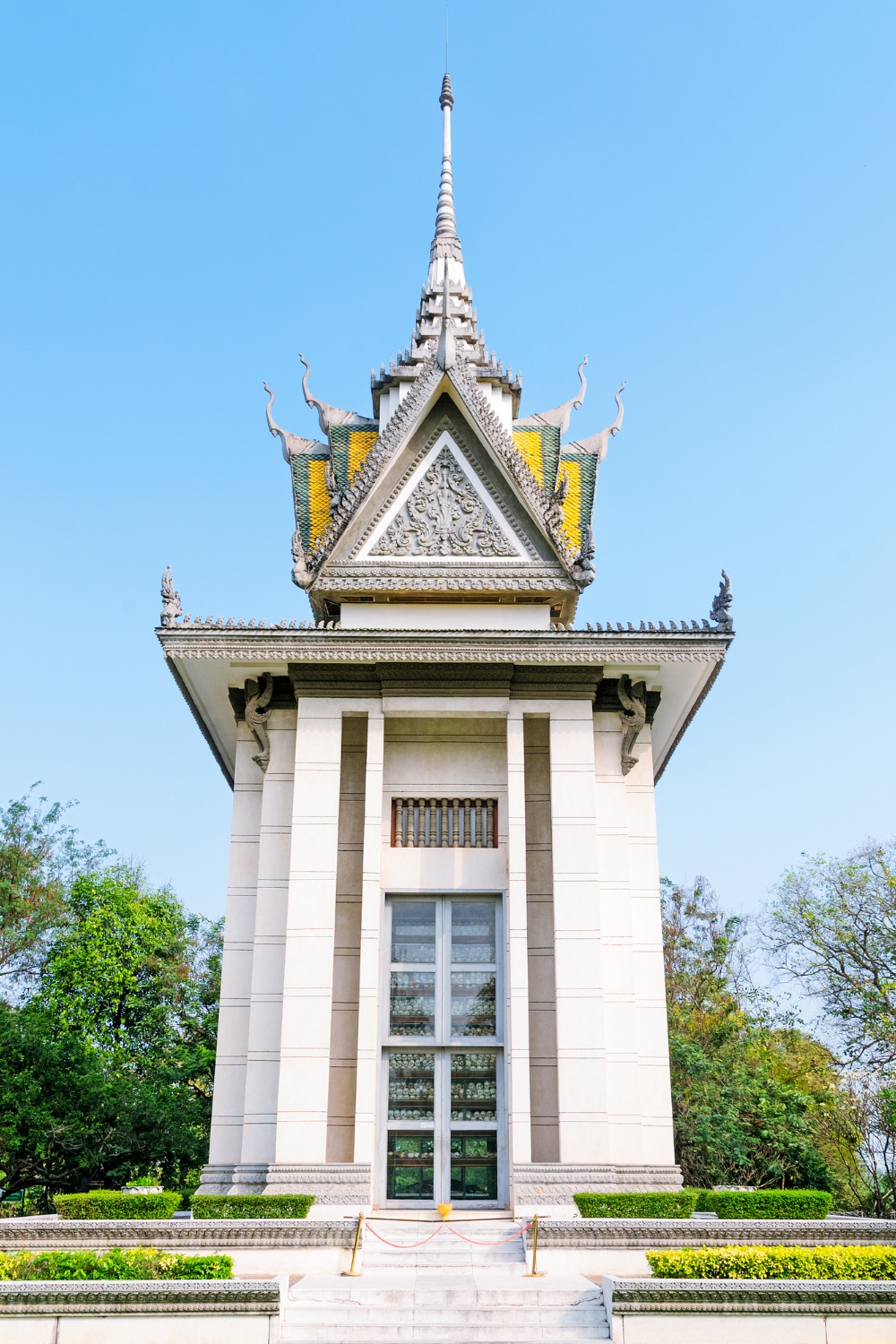
Located 15 kilometers south of Phnom Penh, the Choeung Ek Genocidal Center represents one of nearly 300 killing sites used during the Khmer Rouge regime. This memorial site serves as both a place of remembrance for the estimated 17,000 people killed here and an educational center dedicated to preventing future genocides.
Memorial Stupa and Preserved Evidence
The centerpiece of the memorial is a 62-meter-tall Buddhist stupa containing over 5,000 human skulls and bones, arranged by age and gender as a powerful reminder of the victims’ humanity. The stupa’s glass walls allow visitors to see the remains while maintaining dignity and respect for the deceased.
The site preserves mass graves, many still containing clothing fragments and bone pieces that surface after seasonal rains. Marked paths guide visitors through the memorial while providing historical context and encouraging reflection on the causes and consequences of genocide.
Educational Programs and Historical Context
The memorial includes an audio guide system that provides detailed historical background, survivor testimonies, and analysis of how the genocide occurred. The educational approach emphasizes understanding the warning signs of genocide and the importance of protecting human rights and democratic institutions.
The site serves as a place of pilgrimage for Cambodian families seeking to honor relatives who died during the Khmer Rouge years. Observing these private moments of remembrance helps visitors understand the continuing impact of this historical tragedy on Cambodian society.
Distance from city: 15 kilometers
Opening hours: Daily 8:00 AM – 5:00 PM
Entry fee: $6 USD (includes audio guide)
Duration: 2-3 hours recommended
Transportation: Tuk-tuk or organized tour
7. Mekong and Tonle Sap Riverfront – Urban Waterscape
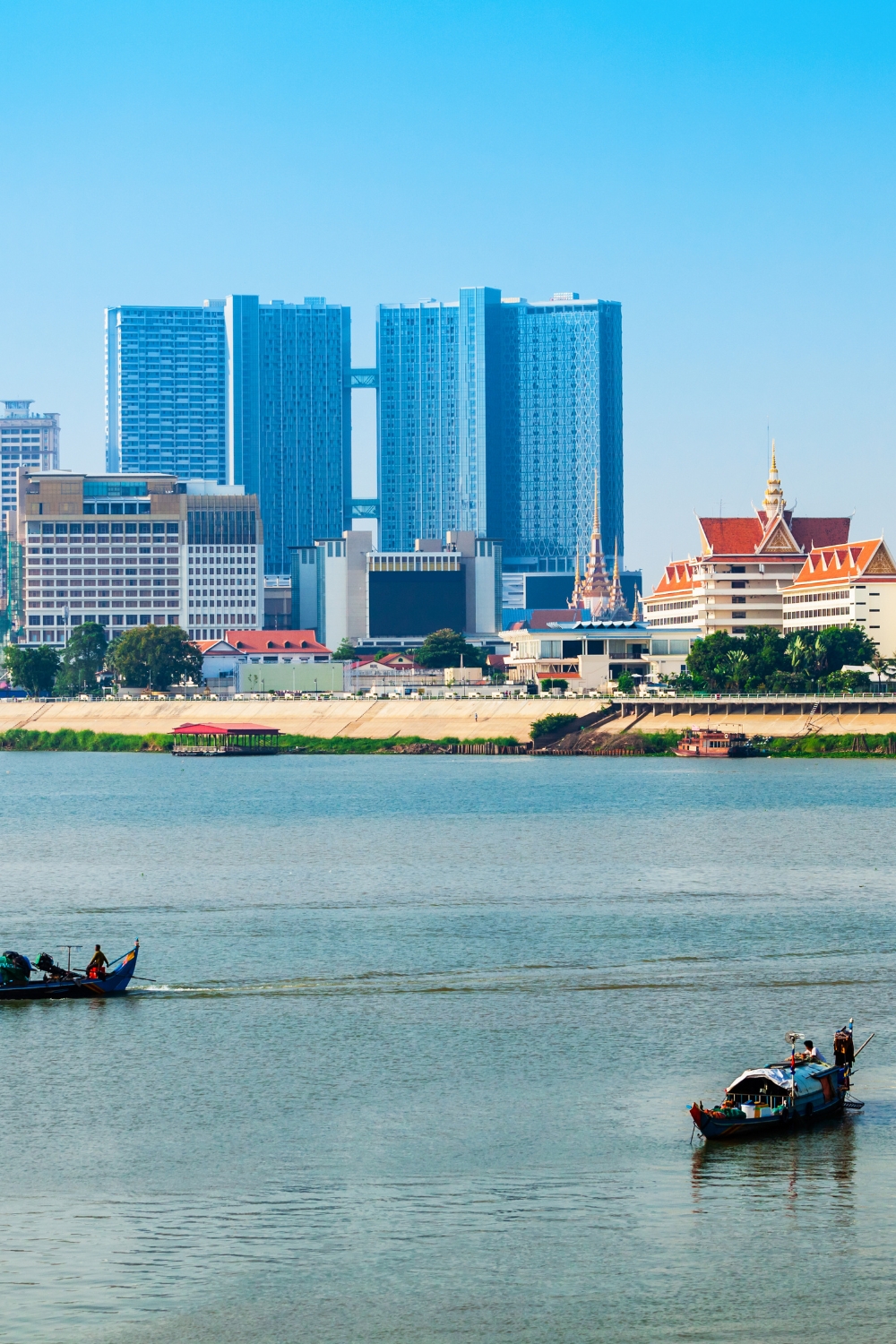
Phnom Penh’s riverfront, where the Mekong and Tonle Sap rivers meet, forms the heart of the city’s social and economic life. This waterfront area, known as Sisowath Quay, combines scenic river views with bustling commercial activity, creating one of Southeast Asia’s most dynamic urban waterscapes.
Sisowath Quay and Riverside Promenade
The riverside promenade stretches for several kilometers along the Tonle Sap River, offering a pedestrian-friendly space that comes alive especially in the early morning and evening hours. Local residents use the area for exercise, socializing, and enjoying cooler temperatures, while vendors sell everything from fresh fruit to books and souvenirs.
The promenade provides excellent views of the river traffic, including traditional fishing boats, passenger ferries, and cargo vessels that demonstrate the river’s continuing importance for transportation and commerce. The constant activity creates a fascinating display of daily life in a river city.
Restaurants and River Views
The riverfront area hosts numerous restaurants and cafes, ranging from local street food vendors to upscale establishments offering international cuisine. Many restaurants feature terraces or balconies that provide excellent river views, especially beautiful during sunset when the water reflects the changing sky colors.
The area’s restaurant scene reflects Phnom Penh’s growing sophistication, with establishments serving traditional Khmer cuisine alongside Vietnamese, Chinese, and Western options. The riverside location creates a more relaxed dining atmosphere compared to the city’s interior areas.
Activities: Walking, dining, river views, people watching
Best times: Early morning, late afternoon, evening
Atmosphere: Social, scenic, mix of local and tourist activity
Dining: Wide range of options and price levels
8. National Museum of Cambodia – Khmer Cultural Heritage
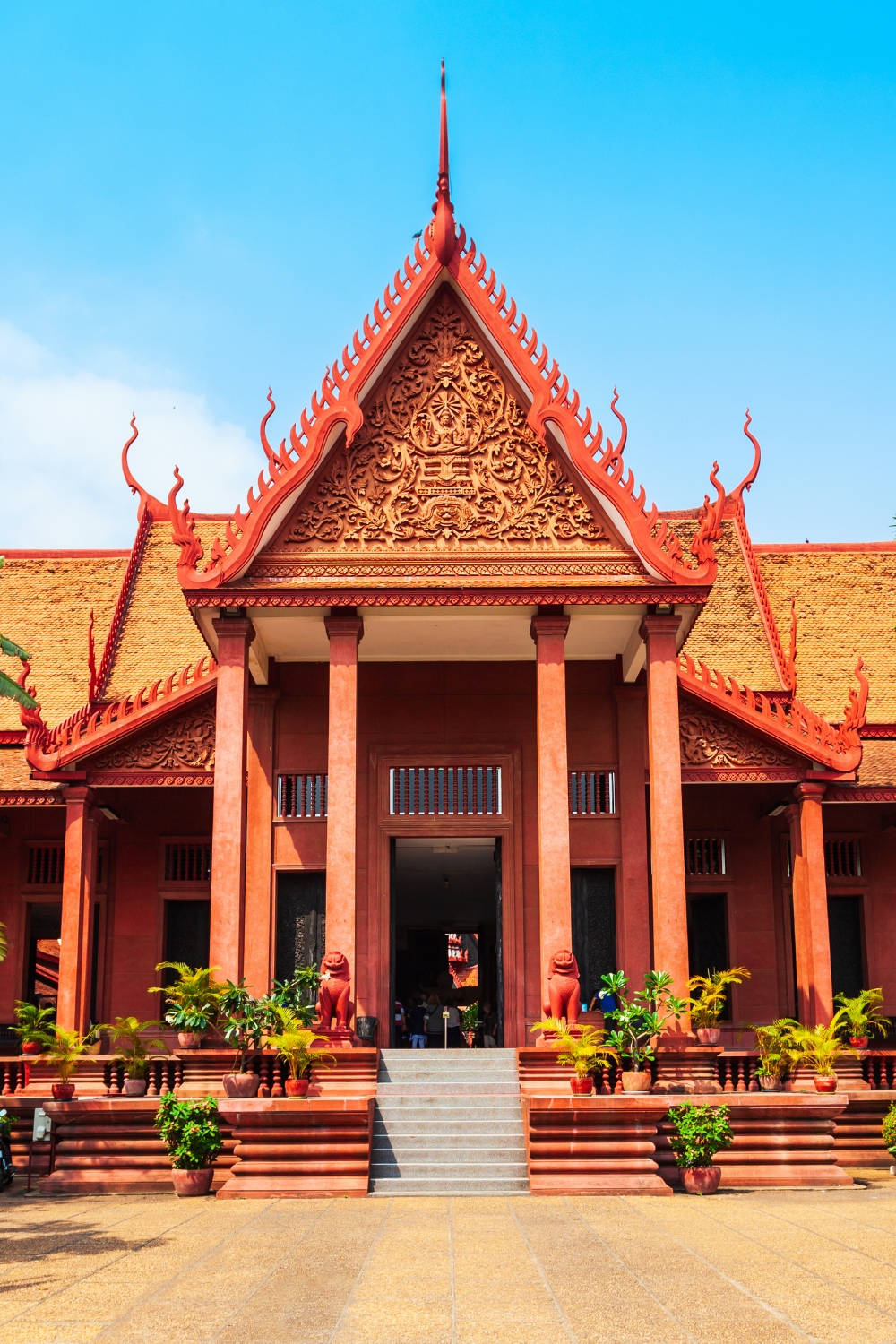
The National Museum of Cambodia houses the world’s finest collection of Khmer art and artifacts, spanning over 1,000 years of Cambodian history from the pre-Angkorian period through the present day. Housed in a beautiful traditional-style building constructed in 1920, the museum provides essential context for understanding Cambodia’s rich cultural heritage.
Angkorian Artifacts and Sculpture
The museum’s collection includes thousands of artifacts from the Angkor period (9th-15th centuries), when the Khmer Empire was one of Southeast Asia’s most powerful civilizations. Stone sculptures, bronze statues, and ceramic pieces demonstrate the artistic sophistication and religious devotion of ancient Cambodian society.
Highlights include pre-Angkorian sculptures from the 6th-8th centuries, Angkorian masterpieces from the classic period, and post-Angkorian works that show the evolution of Khmer artistic traditions. The collection provides crucial background for visitors planning to visit the Angkor temples near Siem Reap.
Traditional Arts and Cultural Preservation
Beyond ancient artifacts, the museum showcases traditional Cambodian arts and crafts, including textiles, silver work, and wooden sculptures that demonstrate the continuation of artistic traditions into the modern era. These displays help visitors understand how ancient techniques and motifs continue to influence contemporary Cambodian culture.
The museum plays a crucial role in preserving Cambodia’s cultural heritage and educating both locals and visitors about the country’s artistic achievements. Educational programs and temporary exhibitions explore different aspects of Cambodian culture and history.
Opening hours: Daily 8:00 AM – 5:00 PM
Entry fee: $10 USD
Duration: 2-3 hours recommended
Best for: History enthusiasts, pre-Angkor visit preparation
Facilities: Audio guides available, gift shop
9. Wat Ounalom – Historic Buddhist Center
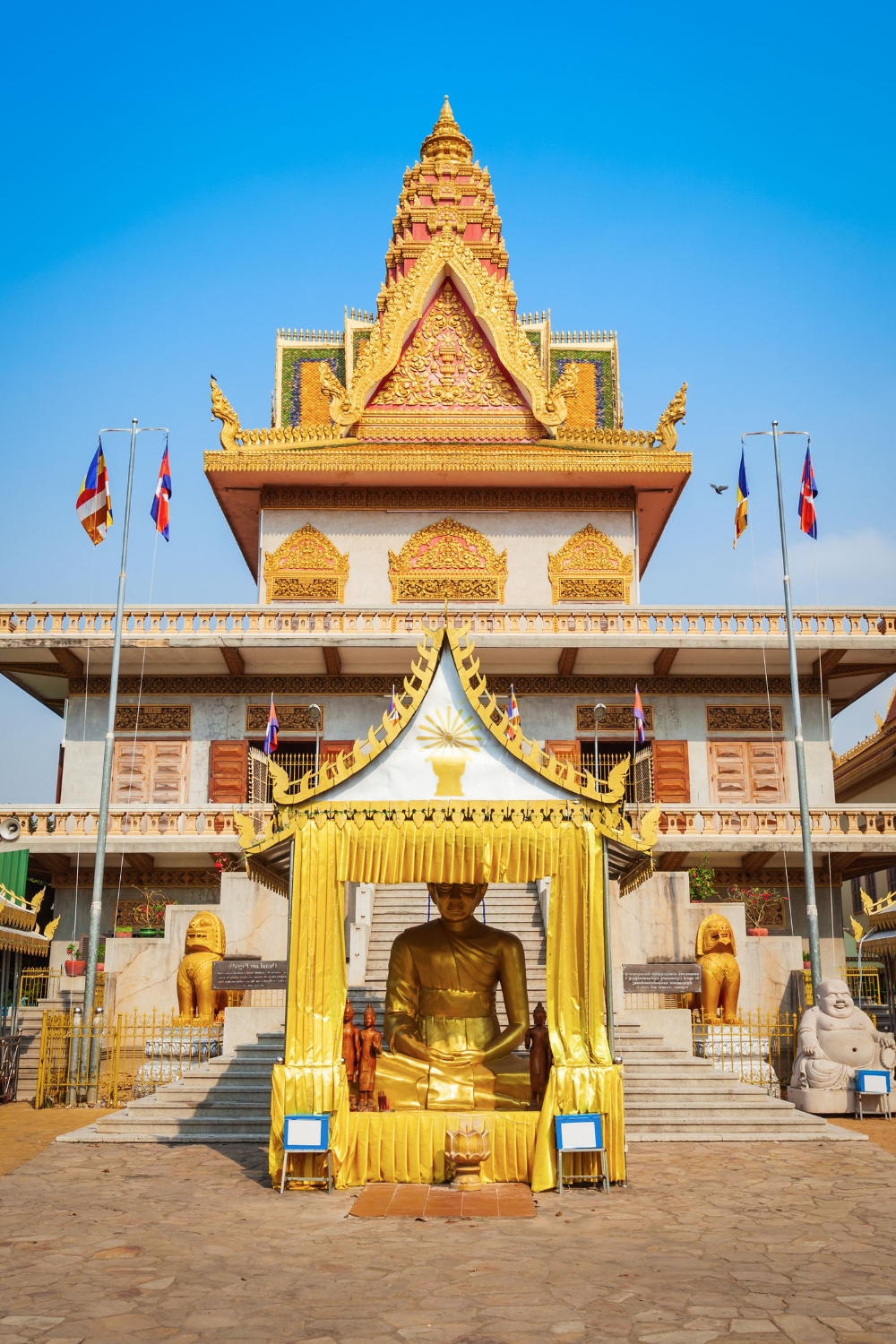
Wat Ounalom serves as Cambodia’s most important Buddhist temple and the headquarters of Cambodian Buddhism. Founded in 1443, this temple complex has survived centuries of change and remains a center of religious learning and practice in modern Phnom Penh.
Religious Significance and Monastic Life
The temple complex houses the Institute of Buddhism, where monks from across Cambodia come to study Buddhist philosophy, meditation, and traditional arts. Visitors can observe daily religious activities, including morning prayers, meditation sessions, and religious ceremonies that demonstrate the continuing importance of Buddhism in Cambodian life.
The complex includes multiple buildings serving different functions: prayer halls, meditation spaces, educational facilities, and residential areas for monks. The active monastic community creates an authentic religious atmosphere that differs from more tourist-oriented temple sites.
Architecture and Sacred Relics
The temple’s architecture represents traditional Khmer religious design, with buildings that follow ancient principles while incorporating repairs and additions from different historical periods. The main sanctuary houses important Buddha statues and religious artifacts, including relics believed to be connected to the Buddha himself.
The temple’s most sacred relic is said to be an eyebrow hair of the Buddha, housed in a special shrine that attracts pilgrims from across Southeast Asia. The continuing religious importance of these relics demonstrates the deep spiritual connections that link contemporary Cambodia to its Buddhist heritage.
Opening hours: Daily 5:00 AM – 6:00 PM
Entry fee: Free (donations appreciated)
Activities: Religious observation, meditation, cultural learning
Etiquette: Respectful behavior, appropriate dress required
10. Independence Monument – Symbol of National Pride
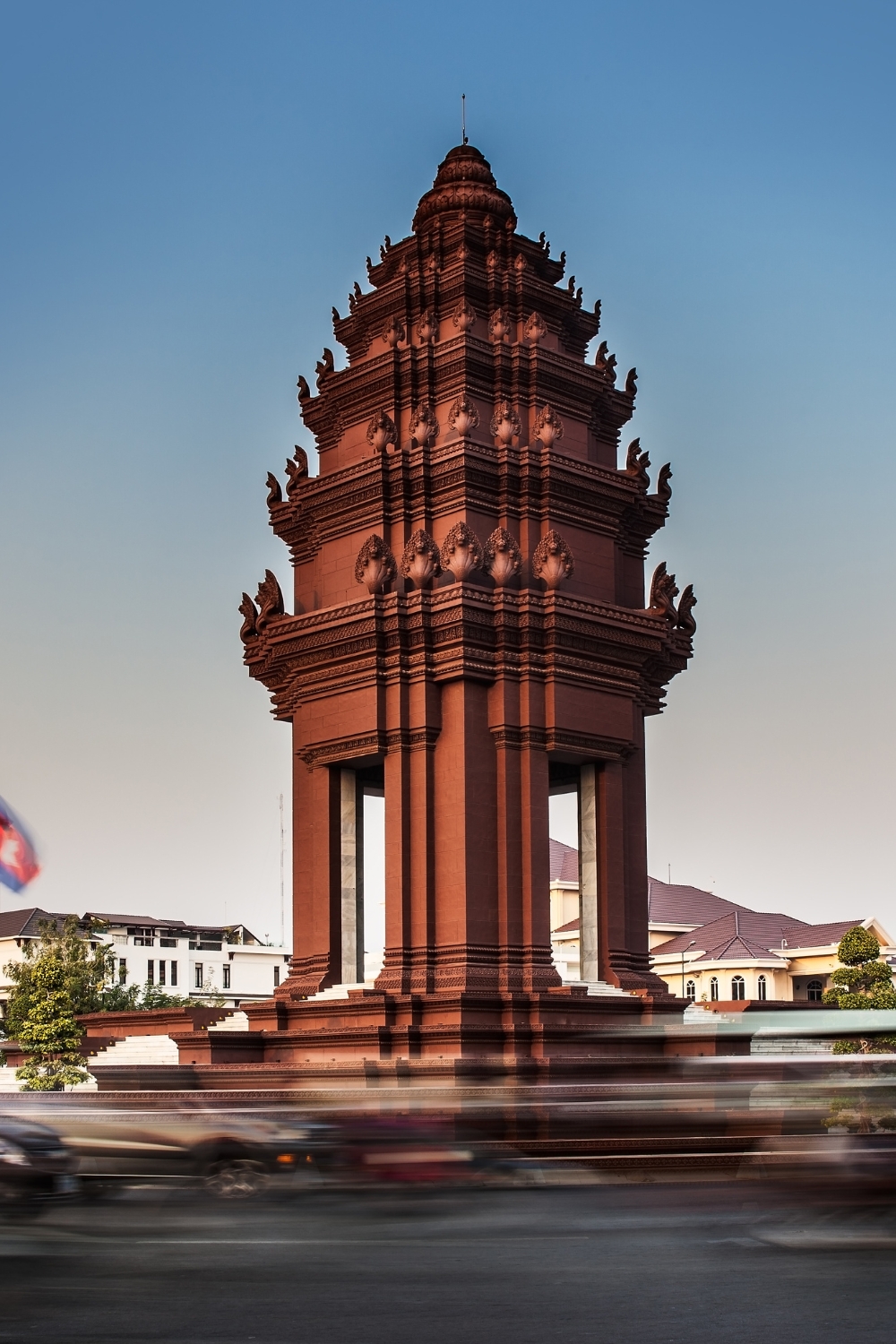
The Independence Monument stands as Phnom Penh’s most recognizable landmark and a symbol of Cambodia’s independence from French colonial rule in 1953. Designed by renowned Cambodian architect Vann Molyvann, this 37-meter-tall monument represents both a specific historical achievement and Cambodia’s broader aspirations for sovereignty and development.
Architectural Design and Symbolism
The monument’s design draws inspiration from traditional Khmer architecture, particularly the central towers of Angkor Wat, while incorporating modern construction techniques and materials. The lotus-shaped spire represents purity and spiritual growth in Buddhist tradition, while the upward-reaching design symbolizes Cambodia’s aspirations for progress and development.
The monument’s location at the center of a major traffic circle makes it visible from multiple directions and creates a focal point for the surrounding neighborhood. Evening illumination highlights the monument’s architectural details and makes it a particularly striking sight after dark.
Historical Context and National Celebrations
The monument serves as the focal point for national celebrations, including Independence Day (November 9) and other important state occasions. These events provide opportunities for visitors to observe contemporary Cambodian patriotism and the continuing importance of independence in the national consciousness.
The area around the monument includes parks and gardens that provide spaces for recreation and reflection. Local families often visit the area in the evening to enjoy cooler temperatures and allow children to play in the open spaces.
Location: Central Phnom Penh, intersection of major boulevards
Best viewing: Evening when illuminated
Activities: Photography, people watching, cultural observation
Significance: Symbol of independence and national pride
Planning Your Phnom Penh Experience
Getting Around the City
Phnom Penh’s transportation options include tuk-tuks (the most popular choice for tourists), motorbike taxis, regular taxis, and ride-sharing services. Tuk-tuks provide the most authentic experience and reasonable prices, though negotiate fares before starting your journey. For longer distances or air conditioning, regular taxis offer more comfort.
The city is relatively compact, making it possible to visit multiple attractions in a single day. However, the tropical heat and humidity make early morning and late afternoon the most comfortable times for outdoor activities and walking.
Best Time to Visit
Cool Season (November-February): The most comfortable weather with lower humidity and minimal rainfall. This peak season brings more visitors but ideal conditions for sightseeing and outdoor activities.
Hot Season (March-May): High temperatures make midday activities challenging, but early morning and evening exploration remain comfortable. Indoor attractions like museums provide air-conditioned relief.
Rainy Season (June-October): Fewer crowds and lower prices, though afternoon thunderstorms can disrupt outdoor plans. The rain often provides welcome cooling and creates dramatic skies for photography.
Cultural Sensitivity and Local Customs
Cambodia’s tragic recent history makes certain topics sensitive, and visitors should approach historical sites with appropriate respect and solemnity. Photography is generally allowed but should be done thoughtfully, especially at memorial sites and active religious locations.
Dress modestly when visiting temples and religious sites, covering shoulders and knees. Remove shoes before entering temple buildings, and observe quiet, respectful behavior during religious ceremonies. Tipping is appreciated but not obligatory, with small amounts suitable for service providers.
Safety and Health Considerations
Phnom Penh is generally safe for tourists, though standard precautions apply: avoid displaying expensive items, be aware of your surroundings, and use reputable transportation. The city’s traffic can be chaotic, so exercise caution when crossing streets or riding motorbikes.
Stay hydrated in the tropical heat, use sunscreen during outdoor activities, and be cautious with street food until your system adjusts to local cuisine. Most hotels and restaurants catering to tourists maintain good hygiene standards.
Conclusion
Phnom Penh offers a complex and rewarding travel experience that combines Cambodia’s ancient cultural heritage with its modern aspirations and unflinching examination of recent history. From the golden spires of the Royal Palace to the sobering memorials of the Khmer Rouge era, from bustling markets to peaceful temples, the city provides insights into both the challenges and resilience of the Cambodian people.
What makes Phnom Penh particularly compelling is its authenticity. Unlike some Southeast Asian capitals that have become heavily westernized, Phnom Penh maintains its distinctly Cambodian character while embracing international influences. The city doesn’t try to hide its difficulties or sanitize its history, making it a destination that challenges visitors to think deeply about issues of war, peace, justice, and human resilience.
The ten destinations highlighted in this guide represent different aspects of the Phnom Penh experience: royal grandeur, religious devotion, historical testimony, commercial vitality, and cultural preservation. Together, they create a comprehensive portrait of a city that has endured tremendous challenges while maintaining its essential character and hope for the future.
Visitors to Phnom Penh often find that the city exceeds their expectations. The warmth and resilience of the Cambodian people, the richness of the cultural heritage, and the affordable prices create conditions for meaningful travel experiences. Many visitors extend their planned stays or return for deeper exploration of Cambodia’s history and culture.
The city serves as an ideal introduction to Cambodia, providing historical context and cultural understanding that enhance visits to other destinations like Angkor Wat, the beaches of Sihanoukville, or the rural communities of the countryside. The experiences gained in Phnom Penh create lasting memories and often inspire visitors to learn more about Southeast Asian history and culture.
Whether you’re drawn by historical curiosity, cultural interest, spiritual seeking, or simply the desire to experience an authentic Southeast Asian capital, Phnom Penh offers rewards that will enrich your understanding of this remarkable region and its people.
